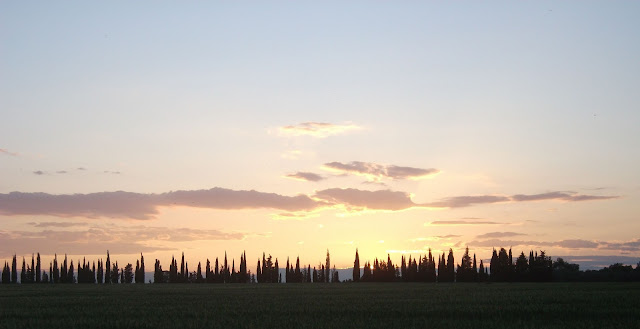I've
gone from steep mountain slopes to an area so flat that mostly
horizons are distant and the skies are huge. I no longer have to toil
up mountainsides, in fact I hardly walk at all. My new means of
locomotion, much though I'd love it to be on horseback or muleback,
is a vélo.
The bike and I we have history in this place, for I've been here
before, and I've explored most of the possible roads, tracks and
pathways in the vicinity, accessible to a bike. Apart from the main
route to Vauvert, the nearest town, a journey which I've done many
times before, I clearly remember the road to Gallician, the nearest
village in the opposite direction from Vauvert, and the road to Le
Cailar, the approach road a tree-lined avenue, dappling the ground
with shade, the village itself, drenched in charm.
 |
| The Road to Le Cailar |
Then
there's the old railway track, long disused. When I was first here a
few years ago, I was wandering along tracks through the peach farms,
in a direction I had not explored before, spotted a steep little
path, climbed up, and found the railway track lying like a secret,
hidden from the path below by bushes and foliage and almost invisible
from the track on the other side. But then, no-one walked along
either track so it was my own special railway. Just as the almond
tree, a short way before the steep path, that was my tree, I stuffed
my pockets with almonds, and went back the next day, for more.
I
went looking for that little path, doubting my own memory. But then I
found, first the almond tree, and
then the path, almost overgrown, leading up to the railway. But still
visible. I push the bike up the short slope and over the old railway
track, and down onto the surfaced cycle path. And that's when I see
the marker and remember that that was my guide as to when to turn off
– a old railway metal sign with the number 31 on it.
Memory
can play tricks but the landscape has also shifted. The rise in the
land, the steep path, that's still there, and the railway line of
course, with a whole new crop of pale green plants growing between
the sleepers of old grey wood, sometimes deeply ridged and knotted,
sometimes curving a little, buckled under the sun of so many summers.
These soft lime green plants may well turn into late summer's thorny
stalks scratching at any unwary ankles that step along the sleepers
of the old railway line.
But
I don't imagine anyone walking along here, not now, now that there's
la
voie verte,
a smooth surfaced pathway for walkers and cyclists, running
alongside. It used to be just a dirt track bordering the canal. Now
there's often people out walking, youngsters roller blading, a few
cyclists. It goes from Vauvert to Gallician, the next village.
Before
it became a smoothly surfaced cycle path, before the name la
voie verte
had been thought up, it was just another dirt track and when I cycled
along it I never met anyone, ever. Occasionally, a vehicle – a
dusty van or tractor would cross the bridge, wending its way through
the vineyards and groves of peach trees. But these were so much part
of the landscape, crawling slowly along, dust coating their sides and
their wheels, joining the dust that rose in a pinkish cloud behind
them. Sometimes you would hear voices among the groves of peach
trees, their owners hidden from view. Sometimes, a few lines of a
song.
The
low, mechanical sound of a small tractor, spraying the trees, turns
into the drone of insects. People melt into the land. There is so
much growth, of vines and orchards, such clear signals that humans
have been hard at work, but these industrial people themselves are
almost invisible. The vines writhe and bend and twist, green leaves
sprouting from their contorted black wood.
The
peach trees are in full leaf, like the poplars and sycamores, oaks,
almond and fig. Only the acacias are still hesitant, delicate fringes
showing at the end of each twig. But in time they will become more
densely leafed than any of the others, each leaf a spray of miniature
leaves, their blossom just as dense, bouquet upon bouquet, humming
with bees.
The
mas,
farmhouses, are large cream coloured buildings, with courtyards,
outhouses, land around them. You hardly ever see anyone there.
Their
porches are hung with vines, screened by them and other trees –
their land often guarded and staked out by the sentinel cypresses,
cones of darkness waving in the wind. Even the horses doze, flat out
in the morning sunlight, or grouped under shade of trees in the
afternoon. The white and restless herons stalk the fields with the
white horses and the black bulls. All the other birds are mostly
invisible in the bamboo, marsh grasses and reeds that screen the
ponds.
Sunsets are spectacular. A few clouds catch the light and turn wondrous colours. This whole place in fact is utterly magical. I am hugely grateful to the association Les Avocats du Diable Vauvert for the chance to stay here again.






Comments
http://www.solitary-walker.blogspot.co.uk/2008/11/it-took-me-5-hours-to-walk-across-this.html
... and this from Saint-Gilles to Vauvert...
http://www.solitary-walker.blogspot.co.uk/2008/11/snails-signpost-and-semi-naked-german.html
This Via Tolosana is magnificent, and I'd walk it again given half a chance...
j'envie votre parcours, avoir le temps de voyager autant, tout autour de l'Europe.
De belles images qui font rêver.
merci de nous les faire partager.
Jorge